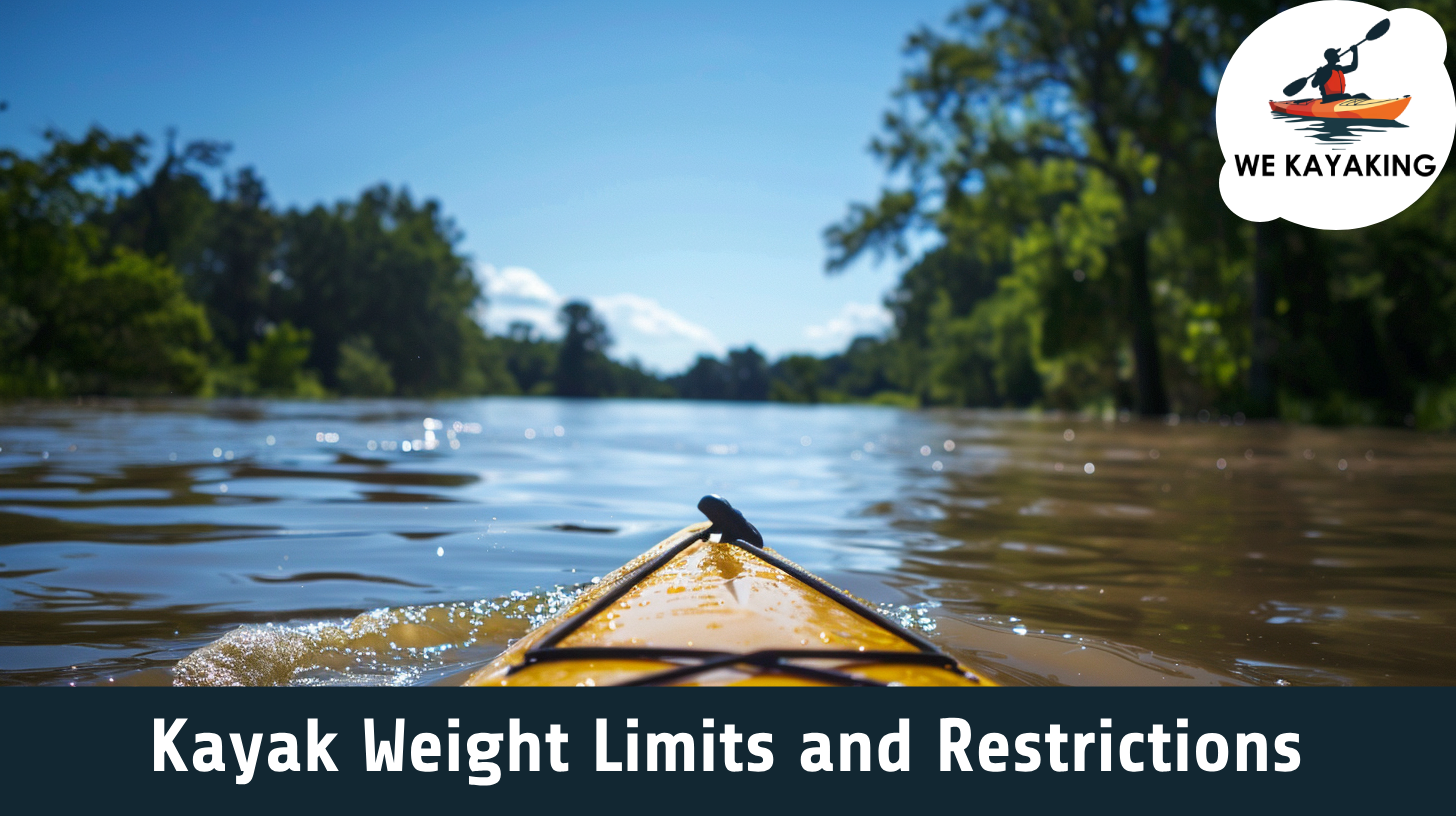
Kayak Weight Limits and Restrictions
The weight limit of a kayak is a crucial aspect that determines how much weight it safely supports, including the paddler and any gear or supplies. This limit is essential to understand, as exceeding it compromises the kayak’s stability and performance, increasing the risk of capsizing.
Recreational kayaks have weight limits ranging from 250 to 300 pounds (113 to 136 kg), suitable for calm waters and light usage. Touring kayaks, designed for longer trips, have higher limits between 350 to 400 pounds (159 to 181 kg). Specialized kayaks, like those for fishing or tandem models, support even more weight, sometimes up to 500 to 600 pounds (227 to 272 kg), to accommodate extra equipment or another person. Children’s kayaks have lower limits, 100 to 150 pounds (45 to 68 kg), due to their smaller size and the lighter weight of young paddlers.
Table of Contents
What is the weight limit of a kayak?
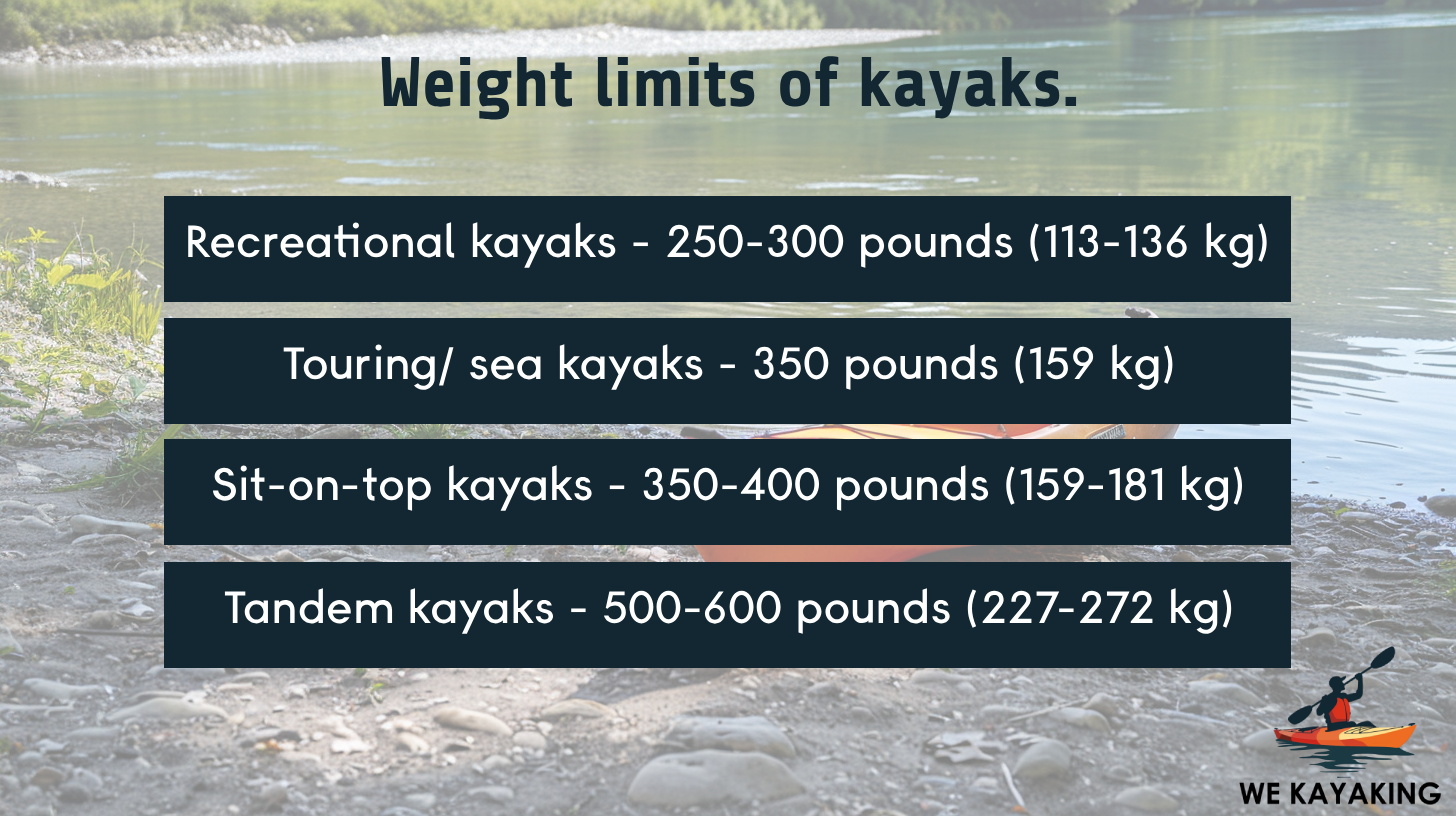 The weight limit of kayaks differs from kayak to kayak. It is determined by the cargo it is able to store effectively, and the activity it is used for. Understanding the weight limit for each type of kayak, including the weight of the paddler and any cargo, is crucial for safety and optimal performance.
The weight limit of kayaks differs from kayak to kayak. It is determined by the cargo it is able to store effectively, and the activity it is used for. Understanding the weight limit for each type of kayak, including the weight of the paddler and any cargo, is crucial for safety and optimal performance.
Recreational kayaks are designed for casual use and have a weight limit of 250-300 pounds (113-136 kg). This capacity is suitable for most individual paddlers and allows for carrying moderate gear, ideal for day trips or light fishing.
Touring or sea kayaks, meant for longer excursions on open waters, support up to 350 pounds (159 kg). This higher limit accommodates the extra equipment necessary for extended trips, like additional clothing, camping gear, and provisions.
Sit-on-top kayaks, known for their stability and ease of entry, offer a weight capacity of 350-400 pounds (159-181 kg). Their versatility makes them a popular choice for a variety of activities, including fishing and recreational paddling, especially for larger individuals or those carrying more gear.
Tandem kayaks, designed for two paddlers, have a weight limit ranging between 500-600 pounds (227-272 kg). This limit accounts for the combined weight of two individuals plus any additional cargo, such as camping equipment or picnic supplies, making them ideal for pairs looking to enjoy kayaking together.
Are kayaks with higher weight limits safer?
No, kayaks with higher weight limits are not safer. The kayak safety depends on its design, stability, and suitability for the intended use and conditions, as well as the skill level of the paddler.
Higher weight limits allow kayaks to carry more weight without compromising performance or stability. This is beneficial for larger paddlers or those carrying significant gear, like camping equipment or fishing supplies. However, a kayak’s overall safety is determined by how well it matches the paddler’s size, skill, and the type of water it’s used in.
Take your weight and the weight of any equipment you want to bring into account when selecting a kayak. Ensure the total is within the kayak’s weight limit for optimal performance and safety. The ideal kayak for you strikes a balance between weight capacity and the dimensions, stability, and handling qualities that are ideal for your level of experience and the kayaking environment.
What happens if you exceed the weight limit of the kayak?
Exceeding the weight limit of a kayak impacts both safety and performance. Firstly, the kayak becomes less stable, significantly increasing the likelihood of capsizing. This reduced stability is especially dangerous in choppy or deep water conditions. Secondly, the kayak’s performance is compromised; it becomes harder to maneuver and control, which is particularly problematic in emergency situations or challenging waters. Additionally, the kayak will sit lower in the water due to reduced buoyancy, making it more susceptible to taking on water, especially in rough conditions. This leads to a swamped or sinking kayak. Lastly, overloading the kayak puts extra strain on its structure, which accelerates wear and tear and potentially lead to damage.
When choosing a kayak, it’s crucial to consider not just your body weight, but also the weight of any gear, supplies, or additional passengers you plan to carry. Selecting a kayak with an appropriate weight limit is essential for maintaining stability, performance, and safety. Ignoring the weight limit not only risks your safety but also leads to a less enjoyable kayaking experience, as the kayak won’t handle as well or be as responsive as it’s designed to be under the specified weight limit.
How to know if your weight exceeds the limits of the kayak?
To determine if your weight exceeds the limits of the kayak, observe the kayak’s behavior in the water. If you exceed a kayak’s maximum weight capacity limit, it will become noticeably harder to paddle as the extra weight impacts its efficiency and ease of movement. The kayak will also track poorly, feeling sluggish and unresponsive, which makes steering and controlling it more challenging.
Additionally, the kayak will sit closer to the water line and take on more water, especially in choppy conditions. This is a clear sign that the kayak is overloaded and struggling to maintain buoyancy. These changes in performance and stability indicate that the weight on the kayak is likely exceeding its designed capacity.
Does the type of kayak affect its weight limit?
Yes, the type of kayak affects its weight limit. Different kayak designs are built for specific purposes and conditions, which influences their weight capacity. Recreational kayaks, for instance, have moderate weight limits. They are ideal for casual paddling and light gear. Touring kayaks, designed for longer journeys, come with higher weight limits to accommodate the extra equipment needed for extended trips.
Sit-on-top kayaks, popular for their stability and ease of entry, usually offer higher weight capacities, which is beneficial for larger paddlers or those carrying additional equipment, such as fishing gear. Tandem kayaks, built for two paddlers, have higher weight limits to support both individuals and their gear.
Whitewater kayaks have lower weight limits due to their compact and agile design, prioritizing maneuverability over cargo capacity. Similarly, fishing kayaks are constructed with higher weight capacities to carry all the necessary fishing equipment and catches.
The kayak’s design, material, and purpose are crucial factors in determining its weight capacity, making it essential to choose a kayak type that aligns with the weight it needs to support a safe and enjoyable experience.
How much weight can an inflatable kayak hold?
The weight capacity of inflatable kayaks varies widely depending on their design and purpose. Entry-level inflatable kayaks have lower weight capacities, ranging from 250 to 350 pounds (113 to 159 kg). They are suitable for calm waters and light usage. Mid-range inflatable kayaks hold between 350 to 450 pounds (159 to 204 kg), accommodating one or two paddlers with some gear.
High-performance inflatable kayaks are designed for more demanding conditions, these carry from 450 to 550 pounds (204 to 249 kg), making them suitable for longer trips or more gear. Specialized inflatable kayak models are designed for specific activities like fishing or whitewater and have higher or lower limits based on their design. Fishing inflatables, for instance, have higher weight capacities to accommodate equipment and catches.
How much weight can a 2-person kayak hold?
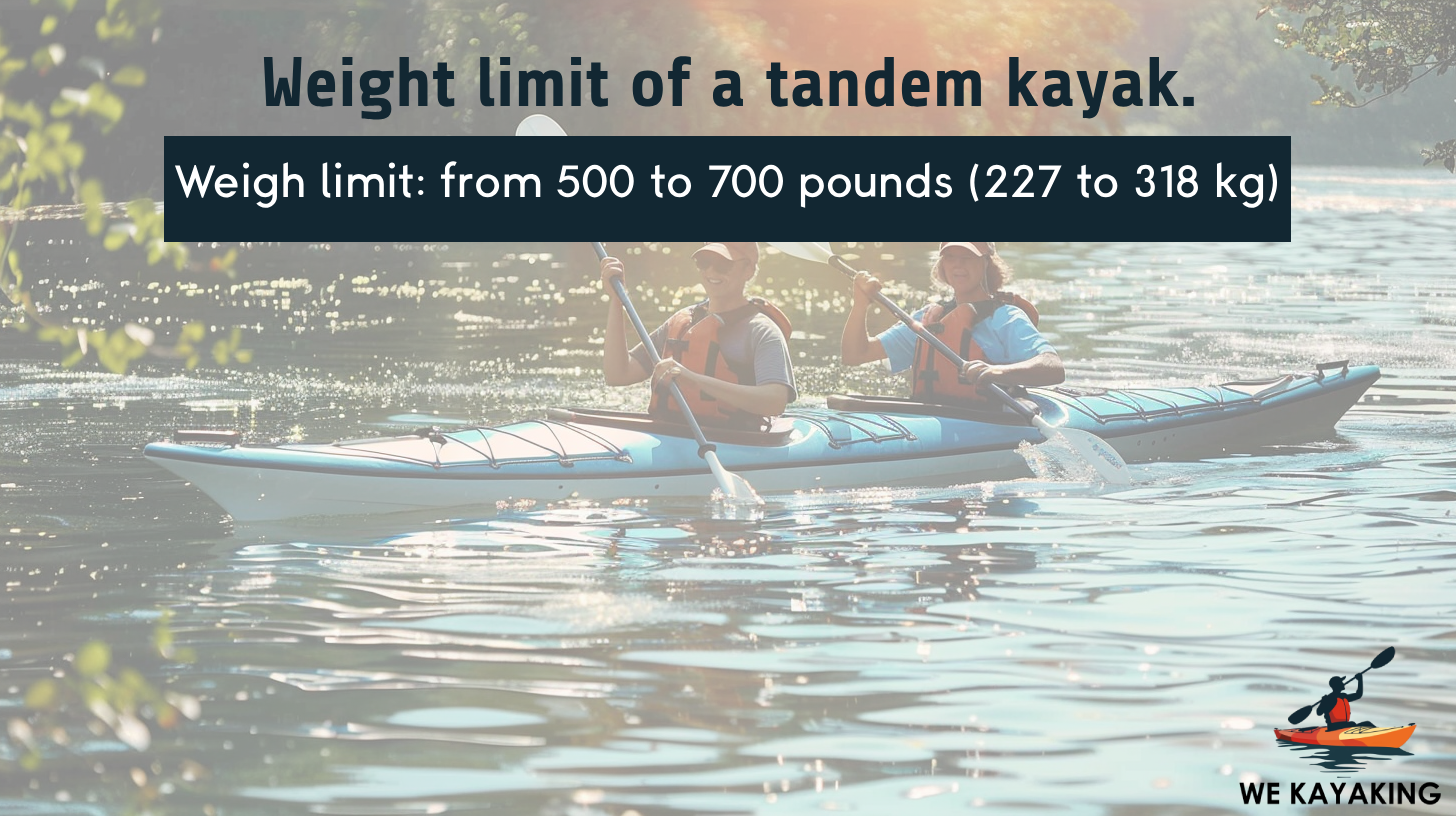 A tandem kayak, also known as a 2-person kayak has a weight capacity ranging from 500 to 700 pounds (227 to 318 kg). This capacity is designed to accommodate the combined weight of two paddlers and their gear. It’s important to note that weight limits varies based on the kayak’s design and construction, so always check the specific manufacturer’s specifications.
A tandem kayak, also known as a 2-person kayak has a weight capacity ranging from 500 to 700 pounds (227 to 318 kg). This capacity is designed to accommodate the combined weight of two paddlers and their gear. It’s important to note that weight limits varies based on the kayak’s design and construction, so always check the specific manufacturer’s specifications.
How much weight can a 10ft kayak hold?
An average 10-foot kayak has a weight capacity of around 275 to 325 pounds (125 to 147 kg). This includes the weight of the paddler and any gear or supplies. However, the exact weight limit varies based on the kayak’s design, build quality, and intended use.
Can a kayak hold 500 lbs of weight?
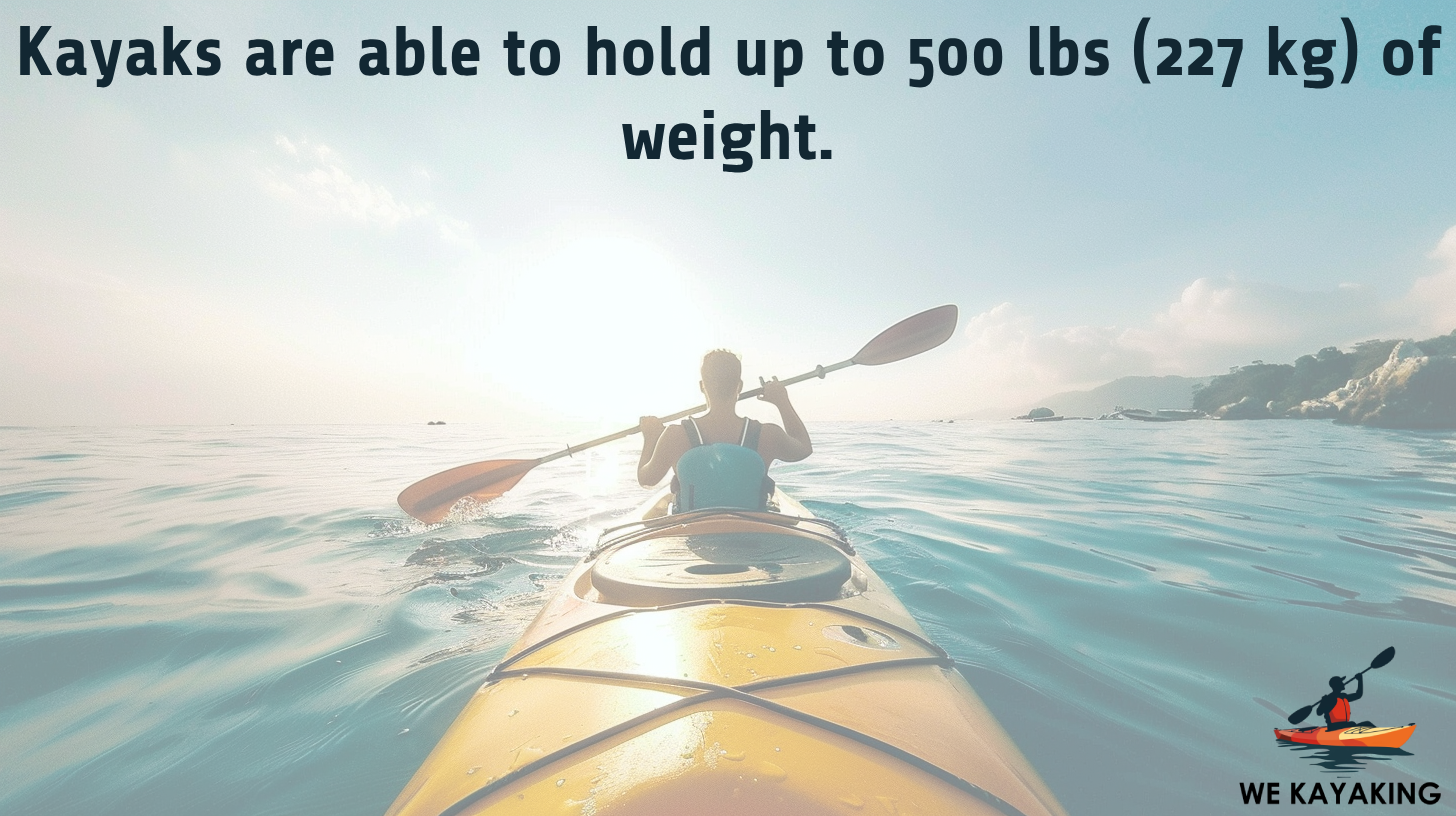 Yes, kayaks hold 500 lbs (227 kg) of weight. These are larger models like tandem kayaks, certain fishing kayaks, or high-capacity recreational kayaks designed for either two people or one person with substantial gear.
Yes, kayaks hold 500 lbs (227 kg) of weight. These are larger models like tandem kayaks, certain fishing kayaks, or high-capacity recreational kayaks designed for either two people or one person with substantial gear.
Can a kayak hold the weight of two adult persons?
Yes, a kayak holds the weight of two adult persons, especially tandem kayaks, which are specifically designed for this purpose. Tandem kayaks have a larger weight capacity, ranging from 500 to 700 pounds (227 to 318 kg), to safely accommodate the combined weight of two adults along with their gear. For two adults kayaking together, selecting a tandem kayak with a sufficient weight capacity is key.
Can a kayak hold the weight of one adult and one child?
Yes, a kayak holds the weight of one adult and one child. Many single kayaks and tandem kayaks are designed with enough capacity to safely accommodate an adult and a child, including their gear.
Single kayaks usually have weight limits ranging from 250 to 350 pounds (113 to 159 kg), which supports an adult and a child. Tandem kayaks, with higher weight capacities of 500 to 700 pounds (227 to 318 kg), offer more flexibility for carrying an adult and child, along with additional gear.
What is the highest weight limit of a kayak?
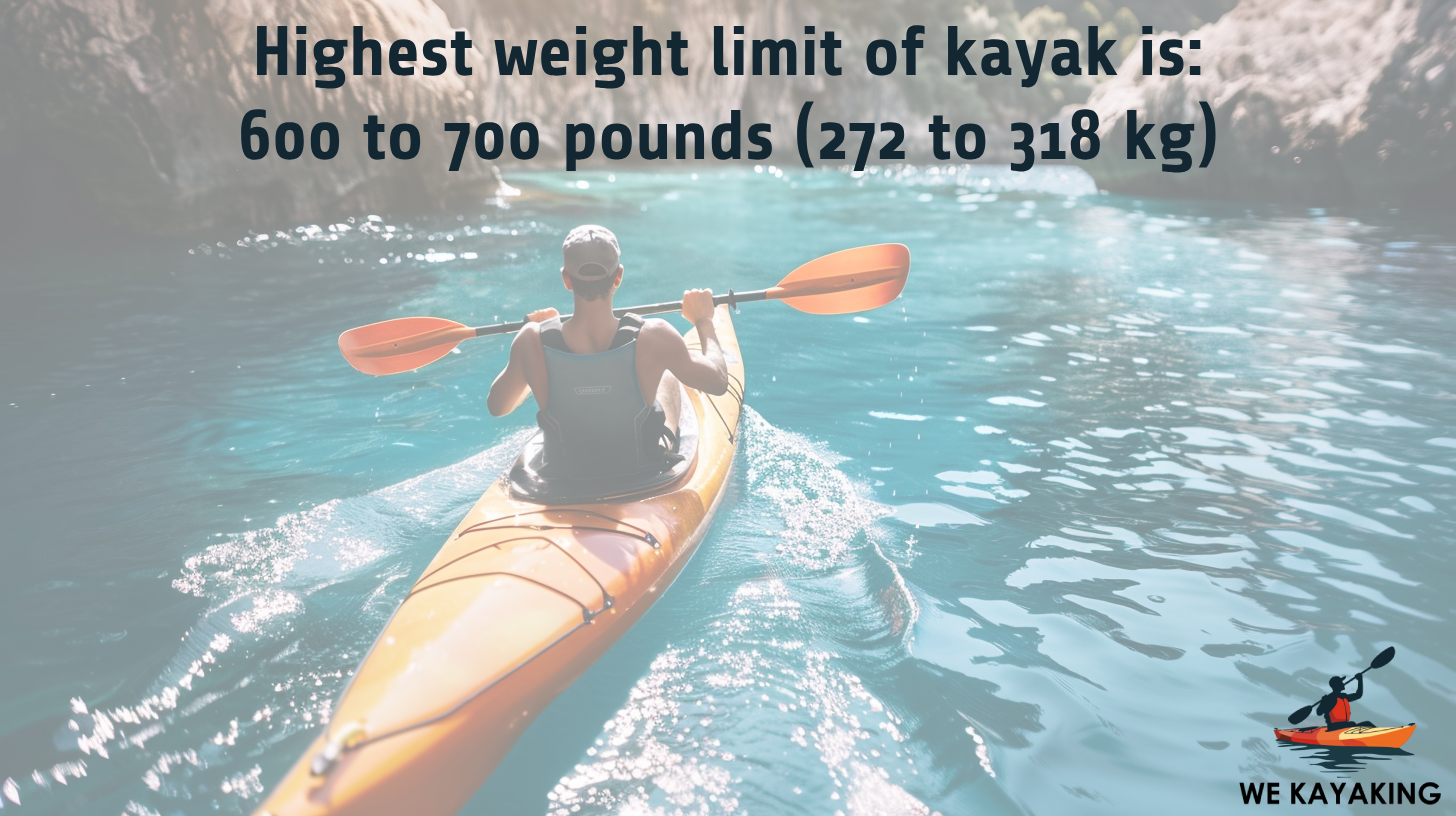 The highest weight limit for a kayak is found in certain tandem and specialized fishing kayaks, which have a capacity of up to 600 to 700 pounds (272 to 318 kg). These high-capacity kayaks are designed to accommodate two adults or one with extensive gear, such as in fishing expeditions. The exact limit depends on the specific model and its design.
The highest weight limit for a kayak is found in certain tandem and specialized fishing kayaks, which have a capacity of up to 600 to 700 pounds (272 to 318 kg). These high-capacity kayaks are designed to accommodate two adults or one with extensive gear, such as in fishing expeditions. The exact limit depends on the specific model and its design.
The Hobie Mirage Pro Angler 17T, a high-end fishing kayak, offers a weight capacity of up to 900 pounds (408 kg), showcasing the upper range of what’s available. This capacity is achieved through robust construction and a larger size, catering to specific usage needs where high weight capacity is crucial.
Are kayaks with a high weight limit expensive?
Yes, kayaks with high weight limits are more expensive. These kayaks are more expensive because they are typically larger and constructed of stronger materials to support the added weight, especially the tandem and fishing-specific models. Depending on their characteristics and layout, high-capacity kayaks cost anywhere from $800 to over $3000 USD.
It is crucial to take both your budget and the kayak’s weight limit into account when choosing a kayak. If you require a high weight limit for tandem use or to carry a lot of gear, you have to invest more. However, there are mid-range options that offer a balance between weight capacity and cost.
